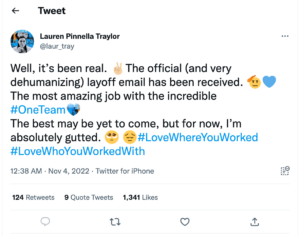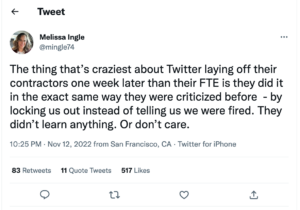The past month has been a tech blood bath, with numerous big-name companies embarking on sweeping layoffs.
In just the past few weeks, Meta culled 11,000 workers, and now there are rumors that Amazon will let go of 10,000 employees—and of course, the company at the forefront of these mass tech layoffs, Twitter, who quite infamously, slashed half its workforce. It is disheartening to see so many highly skilled people losing their jobs, but even more so to learn how many discovered they were no longer employed.
Before looking at the crude methods used by some of these companies to thin their ranks, here’s a simple reminder that behind these numbers and percentages are human beings who made sacrifices to grow these companies, launch new products, craft strategic plans to boost revenue, and forged boldly into the digital sphere, crafting various devices and products that so many of us use daily. These people built their lives around work they believed in, working late, coming in early, missing kids’ soccer games, and more to help these businesses grow and succeed.
In the case of Twitter, there was little to no communication with employees following Musk’s takeover. Staff received a memo on a Thursday morning confirming that some layoffs would commence the following day. Affected workers would receive an email to their personal email by 9 a.m. the next day. But just hours after the initial email was sent, warning of coming layoffs, some Twitter staff began losing access to their work platforms like email and Slack. Notably, Musk’s name was absent from the memo and subsequent layoff notices, which were simply signed “Twitter.” About half of the company, 3,700 full-time employees, were ultimately let go, many who, after years of service, had no thoughtful conversation withHR or even an email, but rather a harsh pulling of the plug.

Now, independent contractors appear to be next on the Twitter hit list. And the company seems to have doubled down on letting people go without letting them know. Contractors are not being notified at all—they are just losing access to Slack and email. Their managers figured out their consultants were terminated when they just vanished from the system—poof. They heard zilch from leadership. Some contractors have shared that they are worried about whether they will receive their final paycheck since many ended up on teams with no full-time employees after the first round of Twitter layoffs.
The response from former Twitter employees has been robust—but it seems that new management is not listening. Melissa Ingle, a content moderation contractor for Twitter, shared the following:

Chaos has reigned supreme at Twitter following Musk’s acquisition of the business. Some laid-off staff has now been asked to return after the company realized they were essential to operations. Other staff members have filed a lawsuit, on the grounds that they were not given enough advance notice before being let go. A current Twitter employee has described the current environment as “ruthless,” as shared with Business Insider’s Jyoti Mann.
Just this week, Musk gave Twitter’s remaining employees an ultimatum—they had 36 hours to commit to ‘hardcore’ Twitter or take three months of severance. Employees were asked to click an icon to respond if they wanted to stay and commit to building “a breakthrough Twitter 2.0.” Perhaps unsurprisingly, record number of resignations have rolled in, so many, that Twitter closed their office building and disabled employee badge access. All this has just added turmoil to an already roiled time, illustrating a current and ongoing example of what not to do when laying off staff, which begs the question: what are good ways to manage layoffs?
+ Give information
Give employees information about the business problems underlying the need for layoffs. Give more detail than you think necessary; this will increase trust with the remaining employees, who will get word of what happened. Fear spreads—information helps quell it. You may not always be able to avoid layoffs, but you can manage the process respectfully.
+ Be certain your layoffs do not discriminate
Ensure there is no discrimination against protected classes of employees and that the layoff criteria are practiced equivalently across all company sectors. Some companies use last hired/first-to-go when determining who to lay off. While this avoids possible allegations of discrimination, experts do not recommend handling layoffs in this fashion as you are likely cutting out all your experienced recent talent or your young, diverse hires. A better bet is to ask managers to make a business case for each person they want to retain.
+ Do the best you can afford for soon-to-be former employees
When layoffs are necessary, do the best you can afford for the employees you are laying off. Offer a healthy severance package, extend benefits to help bridge the divide until they find their next opportunity, offer career placement services, and other economic assistance to help make the layoffs as manageable as possible for employees.
The Bottom Line
When layoffs must happen, remember that humans are on the receiving end of job terminations. Do not do a mass meeting, video or telephone conference call, or send an email to let people go—they deserve better than that, and it will reflect poorly on your company.
Bungling layoffs are essentially a negative branding campaign because how you sunset employees will be discussed far and wide in your industry—especially if you are a big-name company like Twitter.
You can manage letting people go in a way that those who remain are encouraged by your effective, compassionate handling of the situation. Layoffs are never easy and always create uncertainty and fear in the workplace—but there is a way to manage them so that you win in the court of public opinion.
About the author.
An award-winning creator and digital health, wellness, and lifestyle content strategist—Karina writes, produces, and edits compelling content across multiple platforms—including articles, video, interactive tools, and documentary film. Her work has been featured on MSN Lifestyle, Apartment Therapy, Goop, Psycom, Yahoo News, Pregnancy & Newborn, Eat This Not That, thirdAGE, and Remedy Health Media digital properties and has spanned insight pieces on psychedelic toad medicine to forecasting the future of work to why sustainability needs to become more sustainable.




